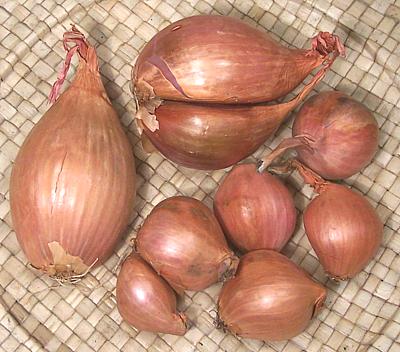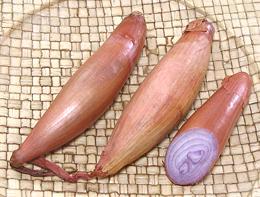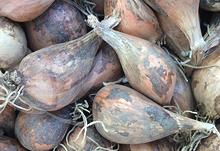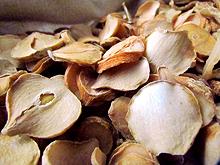 [Échalion (France); Scalogno (Italy); Bawang merah kecil (Malay);
Hom (Thai); Katem kror hom (Cambodia); Small onion, Kanda, Gandana, Pyaaz,
Gundhun, Cheriya ulli, Chuvanna ulli, Chinna vengayam, Sambar vengayam,
Praan (India); Allium cepa var. aggregatum, formerly
Allium oschaninii]
[Échalion (France); Scalogno (Italy); Bawang merah kecil (Malay);
Hom (Thai); Katem kror hom (Cambodia); Small onion, Kanda, Gandana, Pyaaz,
Gundhun, Cheriya ulli, Chuvanna ulli, Chinna vengayam, Sambar vengayam,
Praan (India); Allium cepa var. aggregatum, formerly
Allium oschaninii]
Shallots, probably originating in Central Asia, have a multi-bulb form similar garlic but with fewer, larger bulbs. Sliced they appear similar to a small red onion. Their flavor is similar to red onion with a touch of garlic blended in. They are sharp with "tear power" that can make an onion cry.
Shallots have been a "gourmet" item in the U.S. and were mostly imported from France and sold at around 2004 US $6.99 / pound, but this has been changing. In California (where large quantities are now grown), produce markets have them for as low as 2014 US $1.99 (though you can still pay a lot more in supermarkets and gourmet outlets). This has been brought about by the large and growing Indian and Southeast Asian populations here. Shallots are much used every day items in those regions. In India, shallots are much used in the south, but little distinction is made there between shallots and red onions, which are probably smaller there than they are in North America.
See Details for additional information on this type of shallot.
More on Onion Family.
 [Échalion (France); Allium cepa var. aggregatum]
[Échalion (France); Allium cepa var. aggregatum]
These are primarily grown in France, but also used in England. The specimens in the photo to the left were grown in France, and were typically 4-3/4 inches long and 1-1/8 diameter. I have seen them only once in the stores where I shop, but they may be more available in markets targeting the yuppie demographic.
A writer of authentic Singapore recipes, who is based in London, calls for
Banana Shallots" in all her recipes, though the small Asian shallots are
probably what is used in Singapore. This indicates she considers texture and
taste are suitably equivalent, and the larger size convenient.
 [True Shallot; Griselle (French); Allium oschaninii]
[True Shallot; Griselle (French); Allium oschaninii]
These shallots are found wild from Turkey to Kyrgyzstan. They are
cultivated in France, but are not native there. Some are grown by
specialty growers in North America, particularly by growers of exotic
garlics. While French chefs swear by them, most people don't notice
much difference, except they are more of a hassle to peel. They are
tear shaped and small, about 1-1/2 x 1 inches.
Photo borrowed from produce distributor
Freshpoint under fair use
(small, non-competitive, non-commercial, otherwise unavailable).
.
 [Moo-Seer (Persia); Allium stipitatum, A. hirtifolium
(possibly same species)]
[Moo-Seer (Persia); Allium stipitatum, A. hirtifolium
(possibly same species)]
These shallots are found wild from Turkey to Kyrgyzstan, but are not found in our markets. Some are cultivated, but most are gathered wild in the mountains of Iran, sliced and dried before selling in the marketplaces.
In Iran, the dried slices are often soaked in water for several days,
then boiled to make them milder. They are then often crushed and used to
flavor yogurt. Extracts of the plant are highly anti-bacterial, and are
used in treatment of several diseases throughout their range.
Photo by Ram! contributed to the Public Domain.
What does a recipe mean when it says "One Shallot"? Here's my best estimate based on the shallots available in areas of Southern California that serve particular shallot using communities:
| 1-1/4 ounce | European, American, Near and Middle Eastern recipes. |
| 1/2 ounce | Indian and Southeast Asian recipes. |
The way I interpret "1 shallot" is: if the bulbs are separate or wrapped together only with dried skin, each bulb is a shallot. If two bulbs are wrapped together under a layer that's fully living, they count as one shallot. Thus in the photo above, the European at the top and the Asian at bottom left both count as two shallots while the Asian at bottom center would be one shallot.
li_shallotz 080116 r 141202 r 211123
©Andrew Grygus
- ajg@aaxnet.com - Linking and non-commercial use permitted